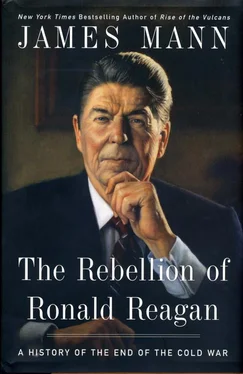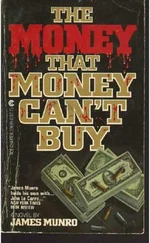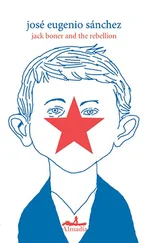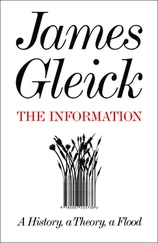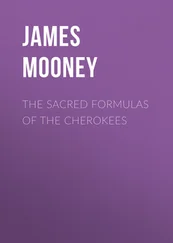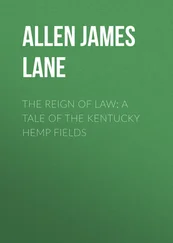Part III tells the story of Reagan’s famous speech at the Berlin Wall in June 1987. The speech was vintage Reagan. In uttering the words, “Mr. Gorbachev, tear down this wall,” Reagan spurned the advice of virtually his entire foreign-policy team, up to and including Shultz. They feared the reproach would alienate Gorbachev or jeopardize his position in Moscow. Reagan judged, correctly as it turned out, that Gorbachev could handle it. Reagan’s speech was much less of a departure from American policy than is commonly imagined, yet it set forth a powerful idea in simple terms and dramatic fashion. The speech reaffirmed the anticommunism on which Reagan had based his career, but it also began to reckon with the idea that under Gorbachev, the Soviet system might be changing. A toughly worded speech, it also maintained support in the United States for Reagan’s subsequent efforts to work with Gorbachev.
Finally, Part IV describes the easing of Cold War tensions during Reagan’s final two years in office. Reagan welcomed Gorbachev to Washington and then visited Moscow, where he proclaimed that the era of the “evil empire” had passed. In between these two summits, Reagan won Senate approval for a major arms-control treaty with the Soviet Union, overcoming the opposition of conservatives from within his own party. Through these endeavors Reagan helped to foster a growing realization inside the United States that America did not need to exist in a state of permanent enmity with the Soviet Union—and that, in fact, the Cold War was coming to an end.
There have been several biographies of Reagan, but these by their very nature cannot concentrate specifically on the final years of the Cold War. Separately, there have also been several books about the Reagan-era negotiations with the Soviet Union (including Shultz’s own extraordinarily detailed memoir). But these books tend to focus, understandably, on the diplomacy, not the political judgments and presidential choices involved in bringing the Cold War to a close.
My own goal was different. I wanted to find what was uniquely Reagan during this period—the personal role and views of the president himself, apart from the work of his subordinates or the diplomacy of his administration. Reagan didn’t operate entirely through subordinates such as Shultz; he had his own unusual advisers and intermediaries. Members of his foreign-policy team often thought of Reagan’s rhetoric as a nuisance or a hindrance; in fact, it was an integral part of his overall approach to the Soviet Union.
The role of any president is inherently more political than that of any of the officials working for him. Presidents must choose when to push initiatives and when to back off, which route to take when cabinet secretaries disagree. They must decide what the American people will support and how to win congressional approval or acquiescence. Reagan, in particular, confronted considerable resistance to his efforts to scale back America’s reliance on nuclear weaponry and to his unfolding relationship with Mikhail Gorbachev.
In the middle to late 1980s, the Cold War was winding down. Gorbachev’s ascent triggered a series of political and bureaucratic battles in Washington. Ronald Reagan was at the center of those conflicts. This is the story of Reagan’s role.
PART I
TWO ANTI-COMMUNISTS
In the final days of April 1987, American newspapers carried a routine photograph of Soviet soldiers drilling in Moscow’s Red Square, preparing for the annual May Day parade, a wave of arms and legs lined up in parallel against the backdrop of St. Basil’s Cathedral. It was what the newspapers call filler art, not meant to convey news or change but rather a sense of the world as usual.
Americans, inured to the tensions of the Cold War, were preoccupied with more mundane pursuits. That spring the Los Angeles Lakers, led by Magic Johnson and Kareem Abdul-Jabbar, dethroned Larry Bird’s Boston Celtics as champions of the National Basketball Association, after the Celtics had themselves defeated the Chicago Bulls and their young star Michael Jordan. America’s dominant computer company, IBM, proclaimed that it would be working with Microsoft, the upstart Seattle software firm to develop a new system that could do several tasks at once in different “windows.” In music, the AIDS charity song “That’s What Friends Are For,” a collaboration by Stevie Wonder, Elton John, Dionne Warwick, and Gladys Knight, had just won the Grammy Award for best song of the year, while Paul Simon’s Graceland was declared the best album. The gossip columns informed Americans that film director Woody Allen and Mia Farrow were expecting a child. Time magazine wrote of the increasing problem of sticker shock in college costs: Stanford University had raised its tuition to $11,880.
Late in the afternoon of April 27, 1987, a cloudy, cool spring day, a secret visitor was smuggled into the White House. Reporters and photographers would have climbed over one another to talk to him and take his picture if they had known he was there, but the attention of the press corps had been diverted. President Ronald Reagan had met with reporters two hours earlier, offering homilies on everything from AIDS to the Iran-Contra scandal, and the correspondents were busy filing their stories. A helicopter swooped low and onto the White House landing pad. Out stepped a familiar figure: Richard M. Nixon, the thirty-seventh president of the United States, who had been living in seclusion ever since being forced to resign thirteen years earlier.
At the Diplomatic Entrance to the White House, Chief of Staff Howard Baker and National Security Adviser Frank Carlucci were waiting, hands outstretched. 1The illustrious greeters hurriedly escorted Nixon inside and up a private elevator to the second floor, the residence quarters of the White House, now occupied by Ronald and Nancy Reagan. Nixon had once lived there himself, of course, but had not returned to his old haunts since August 9, 1974, the day he later called “the nightmare end of a long dream.” 2He had been at the White House twice since, but only for formal ceremonies downstairs: in 1979, Nixon was on Jimmy Carter’s guest list for a state dinner for Chinese leader Deng Xiaoping, and in 1981 he had joined Carter and Gerald Ford in a thirty-five minute stopover on the White House grounds before the three ex-presidents flew to Egypt to represent the United States at the funeral of Anwar Sadat. This time, the occasion was more intimate: Nixon had been invited inside and upstairs for a private chat with Reagan. 3
Nixon’s eyes scanned the living quarters, recording the changes with his characteristic blend of calculation and resentment. The Reagans, never known for parsimony, had given the place a sense of opulence. “I would not have recognized it because of the luxurious furnishings and decorating,” wrote Nixon in a memo for his own files a few hours later. “As I looked up and down the hall, I would estimate that at least $2 million, rather than the $1 million that has been reported in the press, had been expended for this purpose.” By contrast—Nixon reflected to himself—his wife, Pat, had spent less money on redecoration, and had concentrated on the downstairs public spaces of the White House, such as the dining rooms and ballroom. 4
Reagan, dressed in a brown suit, was waiting for him behind a desk in an upstairs study filled with pictures and mementos. Nixon remembered this particular room all too well. It had once been a bedroom, the one where Nixon had slept as president. As he sat down next to Reagan, and Baker and Carlucci settled into chairs across from them, Nixon tried to lighten the mood by launching into the story of when he had first set foot in that room. In 1966, when Nixon, out of office, was in town for the Washington press corps’ annual Gridiron Dinner, President Lyndon Johnson invited him to drop by the White House afterward. To Nixon’s astonishment, he was ushered upstairs to this very room, a bedroom even then. Johnson chose to chat with him from atop the bed, while Lady Bird Johnson nestled under the covers. Three years later, when the Nixons moved into the White House, he had discovered there were wires under that bed—wires, that is, to make tape recordings.
Читать дальше
